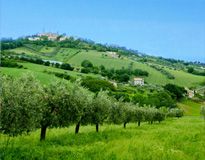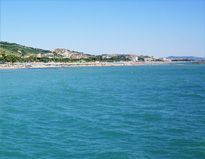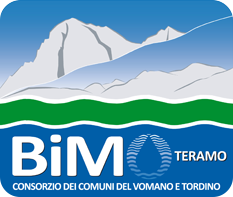
The realization of the Cecilia consular road date back to the 293 to. C. and the conquest of the territory Sabino and Pretuzio, conducted by Toothed Manio Curio with a rapids and violent campaign. The absorption of the territory of the Pretuzis was achieved through the foundations of the Latin colony Hatria (Atria) and Castrum Novum (Giulianova), in 268 -284 B.C.
Throughout the absorption and restructuring of the conquered territory it was open Via Cecilia, along a run frequented in preceding ages. The colonial foundations foresaw, in fact, the creation of road aces that could guarantee a direct control on the new occupation. Probably this necessity was also born from the exploitation of the salty adriatiches in which the salty ostiensis could not be enough for the Roman state in rapids expansion.
In the first line Via Cecilia touches Via Salaria and reaches Interocrium (Antrodoco), from here it detached and it continued toward Amiternum and then it goes up toward Appennino chain. Near the Roman inhabited area of Poggio Umbricchio, it continued up to Montorio al Vomano. The Cecilia, from here breaks in two itinerary of the two adriatic colonies of new foundation: an axle, through Valle San Giovanni, reached Interamniae (Teramo) and then continued, following more or less the course of Tordino up to Castrum Novum; the other arm, instead, following Vomano continued toward Hatria (Atria).
Montorio al Vomano
Along Vomano river, was found the temple of Ercole. This Roman temple covers a notable historical-archaeological importance, it was opened in the 1865. Conspicuous rests of the structure are preserved such as the mosaic floor, realized in opus tessellatum. The floor brings the inscription that, thanks to the mention of the couple to console, can precisely be dated to 55 B.C.
The epigraph, furnishes indications around the realization of the building made by three magistris of a vicus, to evidently localize in the area of Montorio. To around half an hour of pleasant walk, from the small center of Piano Vomano of Crognaleto, it is possible to admire the most ancient monumental archaeological testimony of Strada Maestra: the megalitic boundaries of Colle del Vento that is a boundarie line to control Valle del Vomano.
Teramo: Madonna della cona - Ponte degli impiccati
In Roman age, also in Interamnia the sepulchral areas were prepared along the extra urban streets, in the respect of the Roman laws that forbade to bury the corpses inside the city. In fact the burials of Ponte Messato (or Madonna della Cona) run along the ancient street Caecilia, that conducted to Amiternum (San Vittorino) from Interamnia, as well as, another necropolis had to situate along the street that directed to Castum Novum (Giulianova) from Interamnia. From this last necropolis they originate, in fact, two funeral inscription with the mention of an Archipeta Eunuchus and one Valeria Praetuttiana, as well as another one of Quinto Poppeo, patron of the town hall and the colony (exposed to the Archaeological Museum), used as cover of a grave.
The archaeological site of Ponte Messato, individualized in 1961 near the rural church of Santa Maria della Cona and dug again, from March 2000 up to the 2008. The resurfaced structures belong to a vast sepulchral area interested by depositions from the IX century B.C. up to the imperial age. The italic necropolis, of the IX-there century B.C., it is to burial while that of Roman epoch is to incineration up to the II century d.C. (precisely from the II century B.C. up to the first decades of the II century d.C.), when the burial is reaffirmed with cappuccina graves.
From the italic necropolis there are two separate nucleuses of monumental burials that have also been individualized for typology and location. The native nucleus, located near the Fosso Messato, it has returned great circle gravestones with central pit that have rich outfits inside.
The other nucleus, located in the southern extremity of the site, is constituted by five graves of children, of age between the first months of life and 10 years, of which the greatest three are buried in circle and the newborns in terragne pits.
From the Roman necropolis are been recovered the structures of mausoleums, lined up along the stump of the street Caecilia, The richest and imposing mausoleum of the necropolis reached the 3 ms of height and it was lined up on the road where two twin column pointed out the confinements of ownership of the sepulchral area of the dead, Sextus Histimennius. Inside the burial fragments were recovered barrier and a statue in white (today lost) marble, dated to the First century d.C., representing the dead as a togato. In another mausoleum it has been recovered more than one hundred bones fragments, pertinent to a funeral bed with human representations, animals and floral, on which the dead person was put and subsequently burnt.
Teramo: archaeological site Madonna delle grazie
The dig in the whole area has allowed to isolate numerous pertinent environments, at least in the first phases (republican and augustea), to buildings of housing character that already attest a great extension of Interamnia for the slow-republican period. The environments, with masonries in uncertain work, constituted by pebbles of river cut or, in the most ancient phase, whole, have floorings in painted cocciopesto of red and geometric decorations to plot white lapids that forms motive for grid or double meander. On such building complex in concomitance with the abandonment of ample zones of the city, a plant is installed with characteristics type industrial or handicraft (a probable fullonica for the dye of the cloths). From the recovered archaeological materials it is been able to actually date it use to the whole V sec. d.C., age in which the plant was abandoned and then dejected for the levelling of the whole area that will be turned to external military exercises to the medieval boundaries.
Teramo: Palazzo Melatino
The most suggestive discoveries emerged by the archaeological excavations effected during the jobs of restructuring of building Melatino are a jewel mosaic floor and the rests of walls and marbles policromi:. Under the medieval building, in fact, has appeared a Roman domus on the surface, datable to the First century before Christ but actually used to the IV century after Christ. Of the domus have remained three environments, two side and a plant, greater and from the most sumptuous decorations, that has suffered less remaking in the centuries. The models pompeiani and the floorings in the Rome both imperial and republican have probably inspired the maestranzes that alternated him in the decoration of the rooms of the domus in the various phases. The attention to the style and the wealth of the materials shows the economic and politics importance of the owners of the domus exponents of the dominant class of Interamnia.
Teramo: Domus Piazza Sant'Anna
The archaeological site of Piazza Sant'Anna, has returned, through the excavations, rests of private buildings of Roman epoch and the following cathedral of Sancta Maria Aprutiensis destroyed by a fire in the XII century.
The goods were brought to light for the first time by Francesco Savini at the end of the XIX century, they were object of archaeological investigations, that allow to reconstruct the historical picture of the whole area that goes from the imperial age to that medieval of the site. Notable mosaics have been recovered in three environments of Roman age, pertinent to a private building that was in use from the First century B.C. to the II century D.C. with various rehashes. The mosaics take place externally the ancient cathedral and they lean out on an open area surrounded by columns and tub for the harvest of rain water.
Giulianova
The origins of Giulianova dates back to the roman conquest of the Adriatic coast, with the foundation, around 290 B.C., of Castrum Novum Piceni. For the new maritime colony was chosen a balcony next to river Tordino, and to the coast. It is believed that Castrum Novum Piceni, was strengthened favoring the natural defenses of the ground. The points of access were chosen for an optimal relationship between urban plant and interregional connections: in direction in Rome through the street Cecilia, and through the Salaria to the other centers of the Adriatic coast. The city, was born to practice a penetrating maritime control, and it becomes an important knot road and equipped with a plant port, it achieves also, thanks to its strategic position, a remarkable commercial role. Remembered as a powerful and strengthened center by Plinio, Tolomeo, Velleio Patercolo and Strabone, Castrum Novum Piceni, knew a strong expansion in direction of the coast up to reach a perimeter of over two kilometers.
The building layers of the subsoil, and the fortune discovered in 1828 induce to believe the city suffered more than a devastation: nevertheless Castrum Novum Piceni was reconstructed by August and Nerone.
 en
en 













